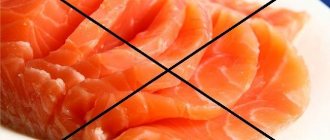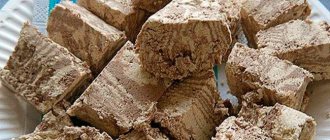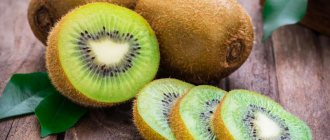Many breastfeeding women want to include some sweet treats in their diet. However, this opportunity is often absent due to the need to follow a strict diet during the lactation process. Despite strict dietary restrictions, it is advisable to carefully study the issue of foods that turn out to be desirable after childbirth.
Can a nursing mother eat candied fruits?
Many young mothers after the birth of their children face a serious lack of glucose. This is not surprising, because every woman spends an amazing amount of energy to produce milk and feed her baby. Depleted reserves of the body always require mandatory replenishment. The easiest option for replenishing energy is eating sweets.
Experts assure that desserts are not only a source of calories, but also an opportunity to get positive emotions. This is due to the fact that a large amount of carbohydrates leads to the active production of serotonin, which is responsible for a good emotional state. Serotonin helps eliminate irritation and fatigue, making women cheerful and positive. This effect on the female body turns out to be extremely important in the first time after the birth of the baby.
However, eating sweets turns out to be potentially harmful. The risks are as follows:
- A large amount of carbohydrates turns out to be a serious burden for the child’s body, which reacts very sharply to the mother’s nutrition. For this reason, there is an increased risk of colic, gas, bloating and other problems with the digestive system;
- Sweets often lead to the development of allergies in children. This is due to the imperfection of the children's immune system;
- Many manufacturers use harmful additives in the manufacture of their products, which include preservatives and dyes. Such ingredients can lead to food poisoning in infants.
It is important to understand that excessive indulgence in desserts will negatively affect the health of the mother herself. There is a risk of developing diabetes mellitus, caries, extra pounds and obesity. For this reason, only moderate consumption of treats can eliminate unwanted health risks.
Despite the potential risks, it is still possible to indulge in sweets. The main task is to choose the right products and use them carefully.
How to eat candied fruits during breastfeeding
When planning to delight yourself with candied fruits, it is extremely important to follow the following rules:
- The introduction of a new product should be gradual. At the same time, it is advisable to begin expanding the menu only 1–3 months after birth;
- After eating the treat, you need to carefully monitor the condition of the baby. It is advisable to allocate several days for control;
- It is important to consider the risks of developing allergies, focusing on the characteristics of your body. For this reason, if an allergic reaction to some type of product may develop, it is advisable to avoid it completely;
- When purchasing a dessert, you need to make sure that the product contains natural ingredients. Moreover, it is recommended to check the expiration dates and integrity of the packaging;
- The safest option is to prepare it at home. Only in this case can you control the entire culinary process and eliminate unwanted moments.
We read about grapes in the diet during breastfeeding here.
Proper and careful expansion of the menu is the best option for those mothers who care not only about satisfying their taste preferences, but also take into account the potential impact on their child.
Recommendations for use during lactation
During lactation, you need to limit the amount of sweets in your diet. You can introduce sweets 3 months after birth, and chocolate ones after 6 months, while observing the measure. You should not use products that contain:
- nuts;
- honey;
- sweeteners;
- flavorings;
- flavoring additives.
During the first meal, you can eat no more than half of the candy. Monitor your baby’s health; if there is no reaction, you can continue introducing sweets into your diet. If your baby is allergic, then all sweets, including cakes, sweets, jam, etc., should be excluded.
Typically, in such a situation, the use of sweets begins after breastfeeding is completed. You cannot introduce several new foods at once, then it will not be clear what exactly the child is reacting to. A food diary will be very useful in this matter; write down all your meals in it, and then it will be clear what caused the rash or problems with the gastrointestinal tract.
If you cannot stop eating confectionery products, then it is better to replace them with dried fruits, cookies or marshmallows, they contain much more vitamins.
How to enter it into the menu correctly?
As mentioned above, a nursing mother should be careful when introducing sweets into her food. Start with a small portion and observe the child’s reaction. It is best to consume sweets in the morning; the reaction will not take long to occur. It is better to introduce chocolates as late as possible, since cocoa usually causes allergies.
Reference! There is an opinion that white chocolate is less likely to cause allergies than dark chocolate; you can start with it, but not more than 10 grams at the first dose.
There are a large number of recipes for making sweets at home. They are usually made from dried fruits. You can also make “Korovka” candies yourself, then you will know exactly what they contain.
Most experts support the opinion that sweets can be present in the diet of a breastfed mother. The main rule is to know when to stop, then neither mother nor baby will have problems. You need to choose your sweets wisely, or it’s better to make them yourself.
The benefits and harms of candied fruits
The beneficial properties of any candied fruit are associated with the composition of the fruits or even vegetables from which they were made. In fact, the composition includes a large number of useful vitamins and microelements. In addition, proper preparation of such delicacies helps to preserve the beneficial properties that are characteristic of fresh vegetables and fruits.
The presence of the following beneficial substances is often noted:
- Magnesium;
- Iron;
- Calcium;
- Phosphorus;
- Potassium;
- Vitamins A, B, E, C, PP, K.
The products also contain proteins, carbohydrates and amino acids.
It would seem that the composition should be rich and useful. However, the high caloric content must be taken into account.
It is advisable to avoid those products that are made from fruits that have a high degree of allergic activity:
The above fruits contain highly allergenic chemical compounds that can cause unwanted allergic reactions.
It is important to note that for those women who are diagnosed with diabetes, eating sweets becomes impossible.
When choosing products, it is advisable to remember that many unscrupulous manufacturers often include chemical additives, flavor enhancers, dyes, and flavorings that are supposed to improve the appearance and give a special aroma to the food. However, such products are strictly prohibited for nursing mothers, so it is best to completely abandon this option. If you want to focus on the beneficial properties, it is advisable to take care of preparing the dessert at home.
Allergy to candied fruits in a child
The immune system and gastrointestinal tract of any infant are imperfect. For this reason, there is a fairly high risk of developing an allergic reaction. In order to protect their babies, nursing mothers must remember certain dietary restrictions. Otherwise, it is almost impossible to predict the consequences.
The main reasons for the development of allergies:
- High content of allergens that can be dangerous for both the woman and her baby;
- Active use by manufacturers of flavors, dyes and other chemical components that can lead to the development of an allergic reaction.
In any case, it is advisable to take care to reduce the potential harm to the health of the young mother and her tiny baby. Moreover, women who breastfeed their children should remember that it is during lactation that the foundation is laid for the baby’s strong immunity. If you do not follow a diet during breastfeeding, there are risks of unwanted health problems and increased individual sensitivity to various foods. It is advisable to give up sweets and allergenic foods for a certain time so that the baby is not unduly influenced by food and can grow up healthy.
How to choose the right candied fruits
If you still need to purchase, it is advisable to try to choose high-quality candied fruits:
- The appearance of the product is one of the most important criteria. Excessively bright color may be attractive, but it is only due to the use of chemical dyes;
- Initially, you need to limit yourself to a few delicacies. In this case, a couple of things need to be placed in a glass of hot or warm water. If the water turns the appropriate color, you can be sure that the product is harmful and that you need to discard it;
- Occasionally, a purchased dessert can even dissolve in boiling water. This happens in situations where manufacturers try to outwit their customers and use low-quality raw materials. Only fiber can remain from fruits, which combines with sugar, chemical dyes, flavorings, and aromas. It should be noted that some manufacturers even prepare treats from waste, as they use the remains of rotten fruits and berries to mix with gelatin and other chemical ingredients. Beautiful, bright and tight products may please you with their appearance and taste, but they will be very harmful.
Read about the diet for mothers here.
Giving preference to bright and dense treats is not the most suitable option. The best way to increase your chances of purchasing quality products is to choose nondescript and pale products that may actually be made from fruits and berries or beets, pumpkins, carrots and corn. Only this type of sweet can be recommended for those young mothers who want to please themselves and take care of their babies.
As a rule, lactating women complain of a poor diet. During this period, almost all usual foods are prohibited. It’s not for nothing that mothers are interested in the question of whether candied fruits can be consumed during breastfeeding in the first month, because their benefits are widely known. Today we will talk about this delicacy and tell you how to properly introduce candied fruits into your diet and consume them without harm to your baby.

Candied fruits are less useful than dried fruits during breastfeeding.
Benefits and possible harm
Candied fruits are fruits boiled in sweet syrup. The benefits and harms are determined by the raw materials from which the delicacies are made: apples, plums, apricots, pineapples, lemons, etc. The raw materials determine one or another composition of the sweet. Each type has a different set of vitamins and minerals, so specific properties may vary. In general terms, the following beneficial effects can be identified:
- improved mood;
- help with stress and depression;
- strengthening the immune system;
- replenishment of nutrients in the body;
- normalization of the gastrointestinal tract;
- removal of cholesterol;
- reducing the risk of developing cancer, etc.
We should not forget about possible harm. First of all, remember that most fruits are allergens, so candied fruits can provoke an allergic reaction in your baby. Store-bought candied fruits often contain a large number of chemical additives, which, in addition to allergies, can cause a number of other negative consequences.
In addition, candied fruits contain a lot of sugar, which increases the risk of developing allergies. This sugar content, if consumed in excess, can negatively affect tooth enamel and figure. Candied fruits are not recommended for people with diabetes, as they can cause a spike in blood sugar. Some candied fruits can cause negative reactions from the gastrointestinal tract, which most often manifests itself in the form of colic and stool problems in infants.
Harm to mother and baby
The danger for mom is that sweets are a high-calorie product and have a negative impact on the figure, can cause obesity, tooth enamel also suffers, teeth begin to hurt and crumble, and caries forms.
A large amount of carbohydrates increases the secretion of gastric juice and heartburn occurs, and metabolism is disrupted.
The baby receives all the nutrients from breast milk. Excess sugar can affect the baby's digestion , causing colic, bloating and gas.
The most important point is the occurrence of allergic reactions in children. Sweets can cause them. This can result in diathesis, which is accompanied by itching. It is necessary to study the composition of the sweets and the expiration date. Sweets whose storage conditions have been violated can cause poisoning.
Important! Choose your products carefully. Eating candy while breastfeeding can cause thrush in the baby.
Can a nursing mother eat candied fruits?
The diet of a nursing mother is very limited, especially in the first months. Products with chemical additives and alcoholic beverages are prohibited; products with a high level of allergenicity are not recommended. Breastfeeding women are not prohibited from eating natural candied fruits. The natural base of the treat will only bring benefits. It is important to know how to use the product correctly so as not to harm the baby.
The first weeks after childbirth are especially important. During this period, the baby’s body, especially the gastrointestinal tract, adapts to environmental conditions. The mother’s task is to minimize the risks that the child may face. In the first month after childbirth, it is not recommended to eat foods that are difficult to digest or strong allergens. Sweets are also not on the list of products needed at this time. Therefore, eating candied fruits, nuts and similar products is not recommended.
Candied fruits can be introduced into the diet at approximately the same time as dried fruits during breastfeeding. It is important to take into account the increased sugar content. Unlike dried apples and pears, which are allowed in the first months of a baby’s life, candied fruits from the same fruits are recommended to be included in the diet 1–2 months after birth. If your diet already contains products that serve as raw materials for candied fruits, you can eat the latter as regular food. If this is a new product, start trying with a small piece in the morning.
If you notice rashes, coughing, watery eyes, itching, or signs of tummy troubles, delay use for a few months. If everything went well, you can gradually increase the dose. It is not recommended to eat too many candied fruits. It is best to limit yourself to 50–100 grams of product per day.
What candies can a nursing mother eat?
I want something sweet to the point of horror!!!!!! And my child is such that he can’t eat anything: but I just can’t get rid of this obsession with eating sweets! When the diet is already normal, it starts sprinkling terribly on my daughter, as if on purpose, even on things that had not been sprinkled on before!!!
I also love cows, but they contain condensed milk, and we were diagnosed with lactase deficiency. I adore them, but somehow I thought it wasn’t possible. Girls, I really don’t know what’s wrong with me. I want something sweet and have no energy. And this takes into account the fact that I was generally indifferent to the cakes there before, I loved chocolate, but even then not all the time. It’s impossible to crave sweets!
I never would have thought that someday I would want something sweet so much, I was always indifferent, but now I want it so much. I want honey or some sugary cakes so that I don’t want to eat it anymore. But it’s still nothing. What should I do?
I’m already choking on my saliva. Especially in the evening or at night. Yes, in fact, if I could, I would always eat only sweet foods, but it’s fraught. BUT in the morning I always eat something sweet, often at lunch, and instead of a snack.
BUT in the evening all Girls, I just don’t know what to do. I've become something of a sweets addict. Hello everyone! It’s just incredible how I want it!!! It all started yesterday. I was just on the street, not Girls, who has encountered this? Lately I've been craving something sweet just terribly. Thoughts about chocolate and cakes make your mouth water, and I dream about cakes with cream at night!
It seems like a dozen cakes at a time and Good evening. Girls, we are on GW. We're a month old. Tell me, what sweets can you afford? Chocolate is not allowed at all and if so, how much? I often drink tea with milk, but I don’t know what to go with it. Before B, I was indifferent to sweets, I never cared about sweets and chocolates, but now I’m just dying next to the counters where the sweets are!!!
I don’t know what to do. Joint purchases. People buy things here at their real price. Flea market New and used. My community. Create your own community of interests, publish materials and set your own rules of communication. Create a community. Answers to BB. Ask a Question. Find girlfriends. Find girlfriends. My diary.
Connect with other moms and make friends, get support and answers to questions. Keep a diary. To help mom. Photo contests Participate and win prizes!
Test drives Apply and become a test drive participant. Horoscopes Mercury in the 3rd phase of the moon mysteriously affects the stars around you. Mom's nutrition. Breastfeeding, lactation problems, quantity and composition of breast milk, nutrition of a nursing mother, breastfeeding technique, postures during feeding, relactation, etc.
Sweets cow during breastfeeding. I want something sweet:. Angelina December 28, Russia, Rostov-on-Don. Julia December 16, Ukraine, Kyiv. Lesya Seen on the site August 20, December 16, Russia, Moscow. Julia December 17, Lesya Videli on the site August 20, December 17, Oksana Videli on the site September 29, December 16, Tasha December 16, Russia, Vladivostok.
Tanya December 16, Russia, Naro-Fominsk. See also. I want something sweet!!! Mobile version Search the site Agreement Copyright Holders. Babyblog is a site about pregnancy and motherhood. Pregnancy and child development diaries, pregnancy calendar, product reviews, maternity hospitals, as well as many other useful sections and services.
Created with Sketch.
Breastfeeding makes strict adjustments to a mother’s diet—especially when it comes to sweets.
How to choose a natural product?
If you are looking for sweets that you can eat while breastfeeding, pay attention to candied fruits. Today there are a large number of candied fruits on the market, so it is important to be able to choose them correctly. First of all, look at the composition. The presence of flavors, dyes and other substances in candied fruits is prohibited.
Look at the appearance of the product. Too bright a color is the first sign of the use of chemical additives. If you decide to check the quality at home, pour boiling water over the candied fruits. Sometimes manufacturers make delicacies without using fruit at all or based on spoiled rotten raw materials. If the product consists only of sugar and additives, it will completely dissolve. If it is based on fruit, only the sugar will melt and the main component will remain. In addition, this will make it possible to see the presence of the dye, since in this case the water will be colored.
What sweets can a nursing mother eat?
It is recommended to consult in advance with a nutrition specialist before pregnancy, during it and after childbirth, so that the child’s health is subsequently strong. During lactation, women always want sweets in order to quickly replenish their own glucose reserves. Research has proven that its deficiency in the body of a nursing mother causes depression, migraines and similar manifestations. What sweets can you eat while breastfeeding? Information will be provided by a antenatal clinic specialist, pediatrician, nutritionist or children's allergist.
Homemade candied fruit recipe for a nursing mother
To be sure of the quality of the products, prepare candied fruits at home. It is best to use pears, apples, and plums as a base. These are the safest fruits for a nursing mother.
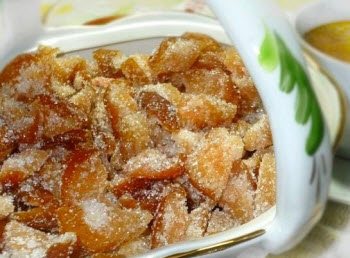
Homemade candied pears for breastfeeding mothers.
Compound:
- Pears - 1 kg.
- Sugar - 1 kg (to taste).
- Citric acid - ½ tsp.
- Water - 1 l.
Preparation:
- Remove seeds, skins and stems from ripe pears.
- Cut into pieces.
- Fill the pears with water and citric acid.
- Bring to a boil and simmer over low heat for 10 minutes.
- Heat 200–250 ml of water and dissolve sugar in it.
- Drain the remaining water from the pears and fill them with the resulting syrup.
- Cook the pears in the syrup for another quarter of an hour.
- Cool.
- Repeat steps 7 and 8 several times.
- Strain the pears and let cool.
- Dry some candied fruit in the oven at 100 degrees and sprinkle with powdered sugar if desired.
A woman's interests and priorities change after the birth of a child. Its main goal is to organize conditions for its proper growth and development. Food should be healthy and enrich the body with all the necessary amounts of minerals and trace elements. Every woman simply loves sweet dishes. Sometimes you really want to pamper yourself with them. It is important to know what sweets you can eat while breastfeeding? At this point in life, the child cannot feed on his own, but is completely dependent on the woman’s choice of diet.
When feeding, it is strictly forbidden to eat sweets, chocolate and cakes from the store. During this period, the body needs proper nutrition, since it is greatly weakened after childbirth. Mommy needs a supply of energy in order to organize the production of a sufficient amount of milk. It is recommended to include in your diet a sufficient amount of carbohydrates, which are found in abundance in sweets.
Desserts help you quickly restore strength and lift your spirits. These factors play an important role during breastfeeding. However, a woman should not mindlessly eat large quantities of sweets. They will have a negative impact on the baby and can even cause food poisoning. Mommy should carefully consider her diet and carefully choose products.
What sweets can you eat while breastfeeding? This issue should be dealt with before irreparable damage is caused to the baby’s digestive system. A woman can eat sweets. It is important to know about those products that have a positive effect on the functioning of the body. You can eat desserts during lactation only taking into account a number of basic rules:
- Avoid excessive consumption of refined sugar. For the same reason, it is not permissible to eat store-bought juices, cheeses and fruit drinks. It is recommended to drink even tea without sugar.
- It is best to avoid sweets and eat dried fruits. They are low in calories and have only a positive effect on the body of mother and child.
- Carbohydrates can also be obtained from vegetables, fruits, bread or porridge. If necessary, energy should be taken from fructose. With its help, you can provide the body with the need for sweets.
Can a nursing mother have candy?
The period of breastfeeding is a time of unexpected discoveries. A woman’s body, her lifestyle, and food preferences change. Although everyone experiences this part of life differently, what most new mothers have in common is an unexpected craving for sweets that is difficult to fight. Sometimes the sudden love for sugar-containing foods is so great that thinking about this food begins to take up a lot of time.
But is it possible to indulge yourself in sweets while breastfeeding? Breastfeeding is a process that requires significant energy expenditure.
During this period, a woman’s body needs an increased amount of calories from food. Experts in the field of proper nutrition determine the sufficient daily calorie content of a nursing mother's diet in the range from to kK. A proper diet for a nursing mother implies both a sufficient level of daily calorie content and a balanced composition of proteins, fats, and carbohydrates.
The main supplier of energy for humans is carbohydrates, which are divided into simple and complex. Complex carbohydrates are found in cereals, some vegetables and fruits, and dairy products. They are slowly processed by the body, due to which the products of their breakdown enter the blood gradually, maintaining a feeling of fullness for several hours. Simple carbohydrates, which include sugar and its derivatives, including candies, chocolate, and confectionery, also supply the body with energy.
Their main difference is that they break down easily, instantly entering the bloodstream. From this we can conclude that constant cravings for sweets are a consequence of a lack of nutrients from which the body receives energy. It is the deficiency of complex carbohydrates that forces a nursing mother to make up for this deficiency from the simplest sources that can be quickly digested and broken down. But what sweets can a nursing mother choose so that her infant does not experience their negative effects?
Although an excess of sweets is not good for anyone, a nursing mother can treat herself with a small amount of her favorite treat. Of particular note is the question of what sweets are possible during breastfeeding in the first month. The best option in the first weeks of the baby's birth would be to limit yourself to sweet tea, leaving other treats for a later date. If this is not enough, you can choose your own dessert, following the rules of moderation, hypoallergenicity and safety.
An approximate list of what sweets a nursing mother can give to a nursing mother after childbirth can be found below. Even though sweets are not vital for the human body, giving them up is difficult even for motivated people.
What can we say about a woman during lactation, whose body is under constant stress and is in a state of chronic stress from fatigue, lack of sleep and constant care for a newborn?
Sweets are one of the few sources of pleasant emotions, but it is important to understand what sweets you can eat while breastfeeding, and what you should avoid. During lactation, you can please yourself with the following products:. Provided that marshmallows do not contain any flavoring, they are an excellent option for a sweet snack. It is worth giving preference to unflavored white marshmallows, without icing or other additives. An airy delicacy that can be bought at any store or prepared at home.
The basic meringue recipe consists of egg whites beaten with sugar. You should avoid multi-colored cakes as they contain dye.
Most ice cream on store shelves contains little milk, but a lot of palm oil and sugar, which makes it undesirable for consumption during lactation.
The solution is to cook it yourself! Homemade ice cream contains yolks, cream, sugar and milk. The cooking technology is simple, and the result will be tasty and healthy. Pectin-based marmalade can be an excellent addition to the diet of a nursing mother.
There are a large number of this delicacy with a natural composition on sale, so you should carefully study the label. The basis of its composition is fruit and berry puree, sugar and egg white. You can make pastila yourself or buy it in a store. Sunflower seeds, which make up halva, contain a large amount of healthy fats that promote the beauty of skin, hair and nails, strengthen the heart, blood vessels and nervous system.
However, halva is an allergenic product and should be introduced into the diet with caution. On the children's goods market there is a large selection of special cookies that can be given to a child from the moment he reaches 6 months.
It is made from natural products, so it is safe for both the baby and the mother. Honey Healthy and tasty, honey is a strong allergen. It should be introduced into the diet of a nursing mother carefully, carefully checking the baby’s reaction to this product. It is advisable to wait until at least a month has passed from the date of birth of the child before enjoying it. A tasty and simple delicacy that is easy to prepare at home is jelly. This dessert is sold in stores in different flavors and aroma, but industrially produced colored jelly always contains synthetic colors and flavors, so it is worth preparing it at home.
Most sweets are not advisable to consume during lactation, since due to the large number of ingredients in the composition, you cannot be sure of their safety for the child.
If a nursing mother wants candy for tea, she should choose products with the simplest possible composition: Caramels and other sweets should not have a pronounced aroma or bright colors - these are signs of synthetic additives.
Homemade pies and buns are also allowed for breastfeeding mothers. The main thing is not to use dubious ingredients when cooking in a fit of culinary enthusiasm. You can refuse ready-made impregnations and toppings; reduce the amount of sugar in baked goods by a quarter; replace honey with molasses, abandon yeast dough, etc.
The list of sweets allowed during breastfeeding is wide, but to prevent them from harming the baby, it is not enough to limit yourself to conditionally permitted products. The mother’s body primarily suffers from excess sweets, but some products, in addition to sugar, may also contain potentially allergenic substances that can affect the child.
The recommendations below will help you understand which sweets you can eat while breastfeeding and which you should avoid. Recognized authority in the field of pediatrics Komarovsky E. In addition to Komarovsky’s advice, it is also recommended to exclude the following products:.
Although sweets as such are not prohibited during breastfeeding, it is imperative to monitor their consumption. You cannot eat them uncontrollably for various reasons, including:. Sweets in the mother’s diet can harm the baby if the product eaten is an allergen.
The younger the child, the higher this risk, so the list of what sweets can be included in the menu when breastfeeding in the first month is conditional. You should also know that the effect of synthetic additives used in the food industry has not been thoroughly studied.
It is only assumed that their use is safe for health, but the list of permitted additives differs significantly in different countries. Why this happens is difficult to say exactly. In the USA, Norway, and Canada, dye E, which gives green color to products, is banned, as recent studies indicate its detrimental effect on the nervous system of children, especially those suffering from neurological diseases.
At the same time, the dye is permitted in Russia and the CIS countries. The situation is the same with dyes E, E, etc. It is also unknown whether synthetic additives affect the quality of breast milk or not. The process of their breakdown has not been well studied, so we cannot be sure of their safety for an infant.
In most cases, the craving for sweets subsides after breastfeeding enters a stable phase: the body has adapted to the new state and milk production occurs in accordance with the baby's needs. This process may take an indefinite amount of time, but you want to ease the irrepressible desire to eat sweets as soon as possible. Is it possible to have sweets while breastfeeding?
Favorite treats will help a nursing mother create a good mood and increase her resistance to stress. The main thing is to choose those sweets that will not harm either the mother or the child, and remember that moderation is important in everything. Save my name, email, and website in this browser for the next time I comment.
Contents 1 Craving for sweets while breastfeeding: a little biochemistry 2 Sweets and breastfeeding: how to combine 2. Did you like the article? Share with friends:. Mom's beauty 0. After giving birth, every woman is overcome by the desire to get rid of excess weight as quickly as possible. Proper nutrition 0. The first months after childbirth are accompanied by serious dietary restrictions for the mother, because nutrition.
Preparation for the New Year, a beloved and long-awaited holiday, begins long before the celebration, c. Breastfeeding 0. Pregnancy and childbirth are a difficult period when every mother’s body is subjected to enormous stress.
When breastfeeding, it is important to follow a diet. At the same time, the body of the mother and baby must. Parents begin to worry about how to wean their child off the pacifier at different ages. Add a comment Cancel reply.
The period of breastfeeding is a time of unexpected discoveries. A woman’s body, her lifestyle, and food preferences change.
Opinion of breastfeeding specialists
What sweets can a nursing mother afford to include in her diet? There are products that cannot adversely affect the growth and development of the baby:
- homemade marshmallows;
- marmalade without harmful dyes and flavor stabilizers;
- yogurt and low-fat cottage cheese;
- candied fruits and other dried fruits;
- baked apples;
- paste.
For nursing mothers, the following foods are not allowed to be included in their diet:
- carbonated drinks;
- any type of chocolate;
- cakes that use rich cream.
They pose a serious danger to the newborn's body. Even a small portion can lead to serious food poisoning. Such products often cause allergies. It manifests itself in the form of an extensive rash and red spots that spread throughout the baby's body. Most often they spread over the tummy and face.
Condensed milk is a dessert for a nursing mother, which until recently was allowed to be eaten during lactation. Today, production technology has changed, so some women are strictly prohibited from eating it, even in limited quantities. You can only eat the product that is produced in full compliance with GOST. Condensed milk is allowed only in limited quantities. It is recommended to add it to tea or dilute it with regular boiled water. In this case, you get a tasty and healthy drink for the body.
Is it possible to have cakes while breastfeeding?
What sweets can a nursing mother eat while breastfeeding in the first month?
Factory-made cake, as we wrote earlier, is on the list of foods prohibited during breastfeeding, since it contains chemical additives, dyes and other substances that negatively affect the human body. Cakes with cream painting are especially unsafe.
As for homemade cakes, these sweets can be consumed in small quantities while breastfeeding, but it should be taken into account that they should be prepared exclusively from products approved for breastfeeding. It is not allowed to add caffeine, cocoa, dyes, emulsifiers or leavening agents to the cake. All these components are harmful not only for the small child, but also for the mother. You can prepare the cream for lubricating the cakes from natural sour cream.
Also note that beautiful homemade cakes decorated with fondant are not for you now. If you were treated to such a cake at a party, simply remove the mastic, and a small piece of biscuit remaining under it will not harm you.
What kind of sweets can you
Sweets during breastfeeding can be included in the diet only if they do not contain milk, sugar, cocoa or caffeine. Almost every candy contains at least one of these components. However, there is a dessert option that can be consumed even while breastfeeding.
Nutritionists allow a woman to include in her diet:
- Turkish Delight. It is recommended to eat dessert only in small portions.
- Kozinaki or grilled meats can be included in the diet.
A woman can pamper herself with such sweets. However, in the first month after the baby is born, you should also abandon them. After this, you should start using it with a small portion. Otherwise, the risk of an allergic reaction on the baby’s skin increases.
Sweets often contain a large number of dyes. For this reason, their use should be avoided during breastfeeding. Any breastfeeding specialist will be able to explain why they cannot be used as a part of the mother’s diet.
How to introduce sweets into your diet
In order for a nursing mother and her baby to tolerate the appearance of sweets in their diet, the introduction of any new food product must follow all the rules:
- You are allowed to try the first sweets and desserts only 1-3 months after the baby is born.
- Under no circumstances should you introduce several new products to the menu at once, only one at a time and in limited quantities.
- After introducing sweets, it is necessary to carefully monitor the child’s condition and behavior. If there are any negative changes, further consumption of sweets should be avoided for a while.
The basic rules for eating desserts and sweets for any nursing mother are gradualism and moderation. If you introduce foods into the diet as recommended by experts and carefully monitor the baby, this will not cause any harm to both the mother and the baby. Therefore, the question of what sweets nursing mothers can eat will disappear by itself.
The benefits and harms of cake for breastfeeding
Not every mother can resist eating a delicious, beautiful and fragrant cake. This delicacy is controversial among many pediatricians and attending physicians. Today, this group of desserts can be divided into two parts:
First of all, it should be noted that it is allowed to eat a cake that is made from the list of permitted foods. Homemade recipes will help you make shortcakes quickly and efficiently. It is best to use natural sour cream as a cream. Caffeine and cocoa are not allowed. Emulsifiers and taste stabilizers also have a negative effect on the baby’s body. And the mother herself will not receive any benefits from using them.
Can a nursing mother have sweets? One can definitely answer the question that factory-made cakes should not be eaten. Quite often you can find harmful additives and dyes in their composition. Nutritionists do not recommend eating artistic paintings. You should only use food products of which the woman is completely confident in the quality of each ingredient.
Just because the cake is made at home does not mean that you can eat it in unlimited quantities. The optimal dose is one hundred grams. Tea and cake should not be eaten every day. At the same time, it is important to monitor the baby’s reaction and note the use in case of diathesis.
Halva is a favorite delicacy
When purchasing such a product in a store, you must be extremely careful. It should not contain cocoa or caffeine. Otherwise, the dish should be abandoned.
Eating halva is allowed only if the woman has no problems with milk production. The dish is permissible to eat only in limited quantities. It is important to first make sure there are no allergies.
Any confectionery product can negatively affect the functioning of the stomach or intestines. If parents detect excessive formation of gases, colic and irritation in the baby, then halva should be completely excluded from the diet.
Features of eating chocolate during breastfeeding
Even a small piece of chocolate can have a negative effect on the baby's body. This may cause a red rash to appear on the skin, accompanied by severe itching.
Chocolate contains a large number of dyes and preservatives that are harmful to the body. For a small, growing organism, their effects can be disastrous.
You are allowed to try a small portion of the treat only after the baby is six months old. In this case, you should carefully monitor the reaction of his body.
The mother is allowed to eat certain groups of desserts only after the baby is one month old. It is important to gradually introduce new foods and carefully monitor his body’s reaction. In this case, the likelihood of a negative reaction can be minimized.
Even during the period of bearing a child, the expectant mother prepares for proper care of the baby. If a young mother has decided to breastfeed her newborn baby, then she needs to take care of following a specialized diet. The diet of a nursing woman includes the exclusion of highly allergenic, fatty, fried and spicy foods from the diet.
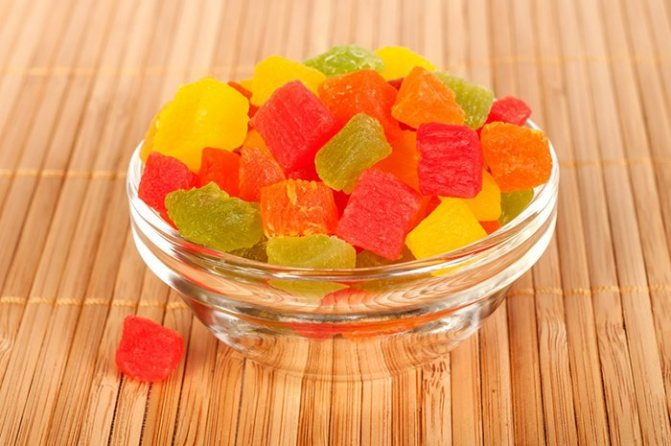
The restriction also includes fresh baked goods, as well as some types of confectionery products. For many breastfeeding women, the question of the possibility of including candied fruits in the diet during breastfeeding remains relevant.
The benefits of candied fruits
The beneficial properties of candied fruits are directly related to the chemical composition of the fruits from which they were made. Candied fruits contain a considerable amount of useful vitamins and microelements. In addition, their structure is rich in plant fiber, which ensures harmonious digestion. The chemical composition of candied fruits is in no way inferior to fresh vegetables and fruits. And this, a kind of exotic delicacy, contains in abundance the following useful components:
In addition, these products contain proteins, carbohydrates and amino acids. Despite such a rich chemical composition, candied fruits made from various fruits are high in calories. A serving weighing 100 g contains up to 500 kcal. Breastfeeding women who have the problem of excess body weight should pay attention to calorie content.
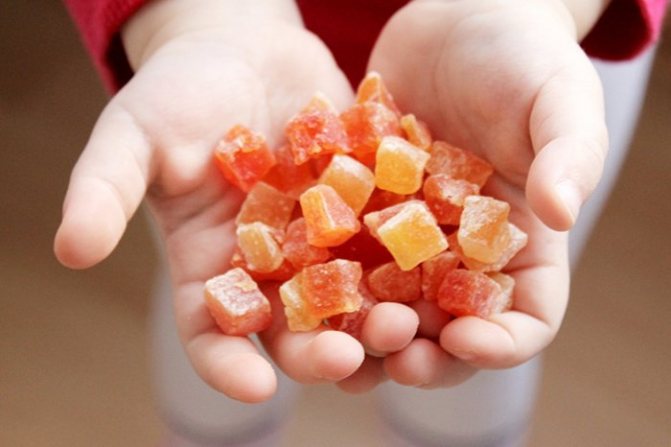
The benefits of candied fruits are not as pronounced as compared to fresh fruits. Very often, medical experts recommend the use of candied fruits as part of a therapeutic or preventive diet. When talking about the benefits of this product for the body of a young mother, it is necessary to take into account the nature of the raw materials from which the candied fruits were made. Candied fruits made from fruits that have a high degree of allergic activity can cause unbearable harm to the body of a nursing mother and newborn baby. These fruits include:
- Citrus;
- Pineapples;
- Strawberry;
- Apples;
- Kiwi;
- Peaches.
The mentioned fruits contain highly allergenic chemical compounds, the entry of which into the body of a newborn child will lead to the formation of an allergic reaction.
If a nursing woman has been diagnosed with diabetes, then the use of this product is strictly contraindicated for her. In addition, this delicacy is not recommended for consumption by women who are overweight. When choosing candied fruits, pay attention to their appearance. Store-bought treats, which have an unnatural bright color and a synthetic odor, are a prohibited product for a nursing woman.
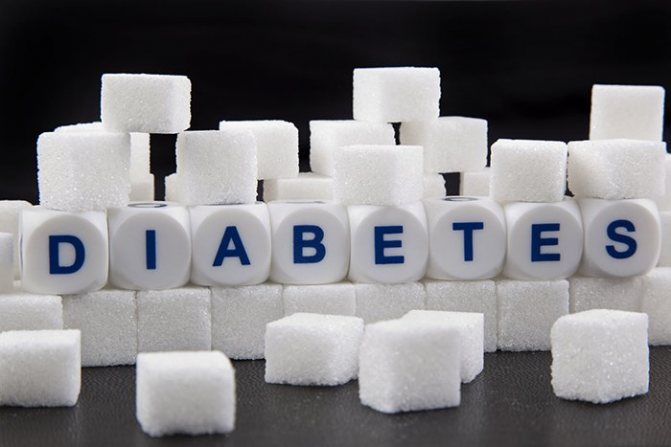
When making the product, manufacturers use a large number of artificial chemical additives, flavors, flavor enhancers and dyes. If a young mother wants to diversify her diet, then she can resort to making candied fruits herself.
Choosing a product
There are a huge number of types of Turkish delight, and a nursing mother is advised to choose the safest option. In particular, it is undesirable to consume treats that contain orange or lemon zest, as well as honey - these products are among the strongest allergens.
The base of Turkish delight with nuts is left with sugar mixed with flour and sugar. This is a high-calorie product that cannot be called healthy for a nursing mother. Nuts, rich in fat, also add calories. Abuse of this dish can harm a baby whose stomach is not ready to cope with fatty milk.
A more acceptable option is Turkish delight based on apple or berry puree. The harm from such a delicacy lies only in an excess of glucose. Unlike traditional recipes, the use of gelatin is allowed in modern cooking. This Turkish delight contains less starch, which is required to give the dish its characteristic dense consistency.
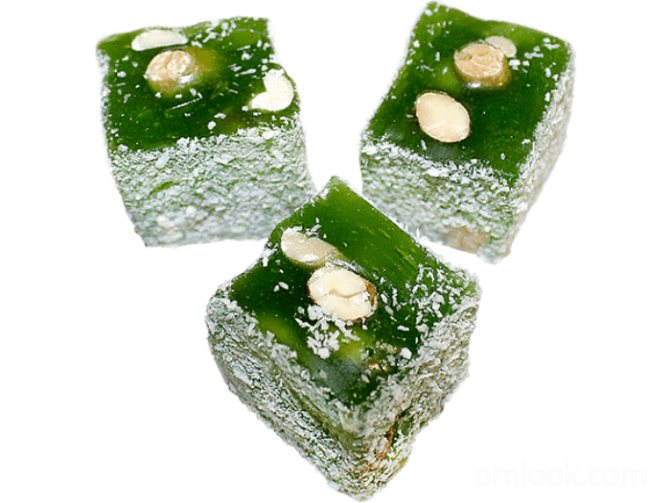
Preference should be given to home-made Turkish delight - only in this case can you be sure that the product does not contain preservatives, flavors and dyes that are added during mass production.
Fruit Turkish delight or a small amount of oriental delicacy with nuts can be consumed little by little as a healthy and tasty dessert, after making sure that the baby does not have an allergic reaction to this product. Read about the symptoms of food allergies in infants at the link.
It is important not to overindulge in sweets, as this harms the body of both mother and baby.
You can start an experiment on introducing treats into the diet only after you are sure that the child’s digestion is established and he adapts well to new foods. Subscribe to our VKontakte group
How to cook at home
In order to enjoy natural candied fruits, you do not need to go to the store and purchase a dubious product. The process of making these natural confectionery products is in many ways similar to the technology for making jam. Natural fruits are used to make candied fruit slices.
To prepare the dish, sugar syrup is prepared in advance, into which sliced fruit is dipped. Boil candied fruits until the candied state is visible. The average production time is 1-2 hours. Boil the fruit slices over low heat, making sure that the sugar syrup does not burn or caramelize.
After the fruit slices have reached the required condition, they are placed in a colander and cooled for 40 minutes. After the fruit slices have gotten rid of the remaining sugar syrup, they are placed on a metal baking sheet covered with parchment and sent to the oven for 10 minutes at a temperature of 40 degrees. The finished product is packaged in cellophane or paper bags, after which it is used as an independent dish or for making desserts and baked goods.
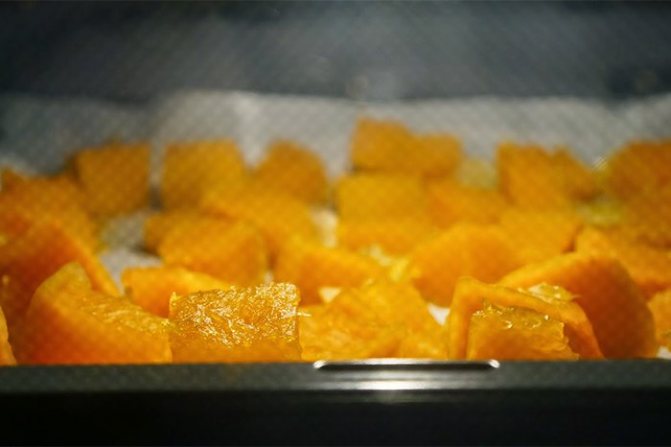
Before including this product in the diet of a nursing woman, every young mother should consult a medical specialist.

